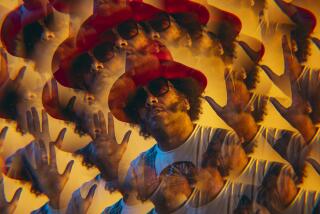LELAND RICE GOES TO THE WALL--IN BERLIN
Los Angeles photographer Leland Rice has had his face to the wall for years, turning ordinary barriers or walls of an artist’s studio into painterly abstractions of striking subtlety and lyrical beauty. In the four years since he last showed his work at Rosamund Felsen’s gallery in West Hollywood, he has trained his camera on other subjects, but his interest in walls--”my obsession,” he calls it--hasn’t faded.
Now he’s back at the gallery with a show of new work (through June 1), based on a wall that is not only the 20th Century’s most loathed structure but--so far as I know--the world’s largest publicly produced painting. Covered with layers of pictographic art, symbols, poetry and slogans, the west side of the wall that divides Berlin has become a 99-mile-long canvas that receives communications from all who arrive there with spray cans, pencils, marking pens and a passion to express themselves.
Photographing the Berlin Wall might seem an obvious move for Rice, but it’s also a significant departure. While working in Germany, he shifted his focus from the benignly anonymous to a hateful symbol of humankind’s divisiveness. Instead of producing soft-colored Ektachrome abstractions with strong ties to color field painting, he has made relatively hard Cibachrome images with strong graphic qualities. Quiet formal abstractions have given way to pictures reverberating with social context. And the inaudible suggestion of human presence in his earlier work has become a clamorous--if still unseen--reality.
If going to a wall so loaded with social implications allowed Rice to continue finding art in manmade fortresses, it also satisfied a self-confessed longing. “I’ve not felt a deep commitment to subject matter for four years,” he said in an interview in the gallery. “Something was missing in the early ‘80s. I wanted to get closer to something that would deal with human life--something that would be more engaging and penetrate what’s on our minds. Without disengaging myself from my formal background, I wanted something deeper.”
Looking around the gallery at pictures of multilingual writings and wall paintings depicting everything from Felix the Cat to an upside-down, Georg Baselitz-style man, Rice continued, “This work wasn’t planned and it isn’t related to the German Neo-Expressionists. That connection is just a coincidence.”
Or a case of serendipity, as Rice tells it. “I went to Hamburg in November of 1983 to produce a dye transfer portfolio of my earlier work. Because I was there specifically for that, I didn’t even take a camera. After a month, I got frustrated (with complications of working with a German studio), so I borrowed a camera and jumped on an airplane to Berlin.
“Being the dumb American that I was, I didn’t even know that the city wasn’t on the border between East and West Germany. I had heard that there was a lot of interesting action at the wall, but I went there just like every other visitor goes there. When I saw it, I was totally magnetized. It’s just incomprehensible for anyone from a free society.”
Friends had directed Rice to a heavily painted area of the the wall where Turkish immigrants have gathered. Among writings ordering “Turks Out” (in German), he found a boggling array of visual material waiting to be photographed. But Rice works slowly and on that visit he only got three or four of the pictures in his current exhibition.
Another year passed before he could return to Germany. It was November again and the weather was miserable, but each day he took a bus, hiked through the Turkish settlement and took pictures along a roughly three-mile length of the wall. What he found was a constantly fluxuating scene. Unusual light conditions provided some decisive moments that would not return on later visits and new paintings obliterated previous ones.
“I never felt threatened. I was never accosted, and although I don’t speak German, language was never a barrier,” he said. He has been surprised and often delighted to discover the meanings of the words he photographed, but that wasn’t his reason for taking particular pictures. “I wanted to be free to respond to pictorial relationships. I didn’t want language to become an issue in composing. I can only account for some of the meanings as logical happenstances.”
Though references to German artists Baselitz and Joseph Beuys appear in two of his pictures, Rice says he also tried to avoid photographing conscious art-making, such as murals that have been painted on the wall by artists. He also steered clear of heavily political sloganeering. What appealed to him was a kind of “folk art” and “a kinetic activity” that he thought had the character of music. “The wall seemed to be a sort of street theater performance,” he said.
Rice found comedy and pathos painted on the wall, even as he observed people who would drive their cars to the barrier on weekends to stroll along it and exercise their dogs. Ironically, he sees his journey to the Berlin wall as a freeing influence. “When you travel, you get the feeling that there are no barriers or restrictions. You can just respond and you think there’s a whole new world out there.”
More to Read
The biggest entertainment stories
Get our big stories about Hollywood, film, television, music, arts, culture and more right in your inbox as soon as they publish.
You may occasionally receive promotional content from the Los Angeles Times.










